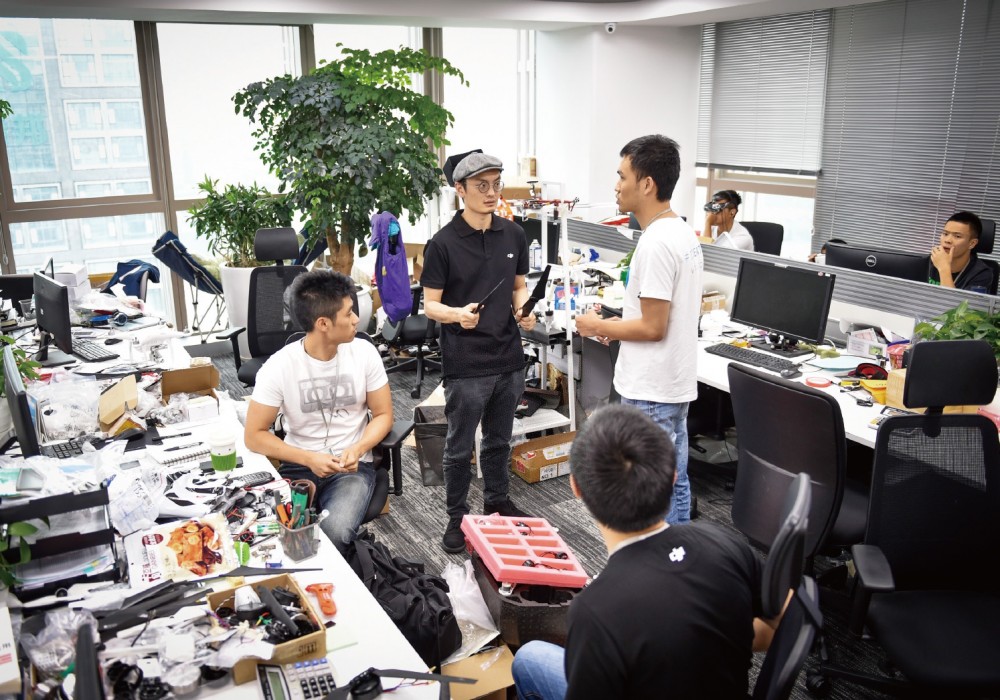The term “unicorn” broadly refers to unlisted start-ups that are valued at over USD 1 billion. They are regarded as important weathervanes in the development of the new economy. While Hong Kong “unicorns” cannot be comparable with their counterparts in the US or China in terms of number and scale, many are beginning to make their marks. They are well placed to propel Hong Kong to become an international hub for innovation and technology.
Su Jie: Changing Market Ambiance Favorable for the Growth of “Unicorns”

Released in July, the Global Innovation Index 2018 indicates that developed economies such as Switzerland, the UK and the US are still leading the world in technological development. Hong Kong and China, on the other hand, climbed up two and five places respectively to rank 14 and 17. Both have made their ways to the top twenty for the first time, demonstrating strong momentum in catching up.
Hong Kong “unicorns” catching up at full throttle
 However, in terms of the number of “unicorn” companies, Hong Kong is lagging much behind Europe, the US and the Mainland. According to Su Jie, Senior Economist for the Department of Development and Planning, Bank of China Hong Kong, input of resources is the crux of the problem. “In Hong Kong, research expenses fail to break the 0.8% mark of GDP and remain much lower than 2.06%, 2.02%, 4.15% and 3.12% spent in China, Singapore, Korea and Taiwan, respectively.” The good news is that the government has proposed to earmark over HKD 50 billion for developing innovative technologies in the latest Budget, showing that it is determined to step up support to drive the growth of Hong Kong’s innovation and technology sector.
However, in terms of the number of “unicorn” companies, Hong Kong is lagging much behind Europe, the US and the Mainland. According to Su Jie, Senior Economist for the Department of Development and Planning, Bank of China Hong Kong, input of resources is the crux of the problem. “In Hong Kong, research expenses fail to break the 0.8% mark of GDP and remain much lower than 2.06%, 2.02%, 4.15% and 3.12% spent in China, Singapore, Korea and Taiwan, respectively.” The good news is that the government has proposed to earmark over HKD 50 billion for developing innovative technologies in the latest Budget, showing that it is determined to step up support to drive the growth of Hong Kong’s innovation and technology sector.
Taking an overview on Hong Kong’s investment atmosphere, Su reckons that investors are, generally, only willing to undertake low-risk investment. Many family foundations have chosen to invest in real estates and the financial market; not much is invested in innovative technologies. Overall, the society is yet to form an ambiance that actively supports innovation and technology with capital. He also pointed out that the market scale of Hong Kong is rather limited. Soaring property prices have made it difficult to develop infrastructure and venues for innovation and technology activities. This, coupled with the high operating costs of start-ups, is restricting the growth of our innovation and technology sector.
Uniqueness most needed in developing innovation and technology
Su suggests that start-ups wishing to tap the innovation and technology market should steer away from industries and scopes where market developments have more or less reached full capacity. Start-ups should find an entry point by addressing major obstacles and inconveniences faced by the public. They should uncover the voids and business opportunities of the market, and at the same time, focus on developing a certain unique territory. What they should look for is not “big and all-encompassing”, but rather “small and beautiful”. If their business can highlight the characteristics of Hong Kong, these start-ups could become pioneers and serve as reference cases for Mainland products or services in the future. He continued that the Hong Kong Exchange’s confirmation to allow companies with weighted voting rights to get listed in Hong Kong will encourage more innovation and technology start-ups to list and secure financing for expansion.
The successful Chinese model for nurturing unicorns
 The experience of the Mainland is also worth studying. According to the Report on Development in Innovative Technologies in China 2016-2017, the state spent 1.4 trillion yuan on research and experimental development, raking second globally. Su saw three major drivers in the rapid development of innovation and technology on the Mainland. “Firstly, the Chinese government is actively supporting innovation and entrepreneurship. A number of incentives and policies were rolled out to support innovation. Secondly, the colossal demand of the Mainland market gives innovation development its needed scale. Lastly, with complementing services, such as the Growth Enterprise Market, the New Third-Board Market, etc, more capital is drawn to invest in developing innovation and technology, and at the same time, creating a good ambience for development.”
The experience of the Mainland is also worth studying. According to the Report on Development in Innovative Technologies in China 2016-2017, the state spent 1.4 trillion yuan on research and experimental development, raking second globally. Su saw three major drivers in the rapid development of innovation and technology on the Mainland. “Firstly, the Chinese government is actively supporting innovation and entrepreneurship. A number of incentives and policies were rolled out to support innovation. Secondly, the colossal demand of the Mainland market gives innovation development its needed scale. Lastly, with complementing services, such as the Growth Enterprise Market, the New Third-Board Market, etc, more capital is drawn to invest in developing innovation and technology, and at the same time, creating a good ambience for development.”
More and more Mainland “unicorns” are topping international lists. Su said that such success comes from the Chinese economy, which is transforming towards high quality and new technologies. The venture capital markets which breed “unicorns” are also becoming more diversified. Moreover, government policies on new businesses and innovation (including complementing measures like guiding funds and co-working space) have created a favorable setting for the continuous development of “unicorns”, which are launched one after another. The ever-increasing salary bonus enjoyed by innovation professionals also helps.
Once-in-a-lifetime opportunities in China
Hong Kong is a bridgehead that connects the Mainland to the world. The Central Government attaches great importance to the development of innovation and technology in Hong Kong. Chinese President Xi Jinping, for example, made a directive to support Hong Kong in becoming an international hub for innovation and technology earlier on. Su considered this a once-in-a-lifetime opportunity. “The state has launched a number of initiatives to drive innovation and technology in Hong Kong. For example, technology and research professionals of Hong Kong can directly apply for science and technology funding by the Ministry of Science and Technology (MOST) and the Ministry of Finance. Hong Kong’s technology talents are invited to enter the National Science and Technology Programmes Expert Database, and technology and research organizations setting up in the Mainland can enjoy import tax incentives, etc.” With the official launch of the Greater Bay Area plan, the construction of the Hong Kong/Shenzhen Innovation & Technology Park in the Lok Ma Chau Loop area will undoubtedly be propelled.
Going forward, Hong Kong technology companies can look forward to going public directly through the local market under the support of state policies. This arrangement is instrumental in transforming research outcomes into products, and in turn closes the long-time gap in industrializing local research outcomes. This may give rise to more local unicorn companies.
Simon Loong: Leveraging on Hong Kong’s Strengths to Create “Unicorn” Miracles

In just a few years’ time, Hong Kong has rapidly become one of the most attractive entrepreneurial hubs across the globe. Not only that many start-ups have chosen to base in Hong Kong, but many young people are now keen to work in the innovation and technology sector. Hong Kong is a very small place, yet, it too can nurture “unicorn” companies that are making news in the market.
WeLab, a local fintech company that focuses on online lending business, is a textbook case. Founded in 2013 in Hong Kong, one of the company’s co-founders of WeLab Simon Loong had worked in the banking industry for more than 10 years. He is very familiar with the lending market and is good at managing risks. Sensing that there was huge room for improvement in Hong Kong’ financial services, he and his friends set up WeLab and accessed the Mainland market in the following year. Under the company’s umbrella are the mobile lending platform Wolaidai and Hong Kong online lending platform WeLend.
Securing a foothold in Hong Kong for global business expansion
 In 2013, when the government began to actively promote the development of the innovation and technology sector, WeLab seized the chance and made remarkable achievements in just six months. Riding on his personal knowledge of Greater China markets as well as the operation experience of WeLab in Hong Kong, Loong began expanding into the Mainland market in the following year. His company was favored by investors.
In 2013, when the government began to actively promote the development of the innovation and technology sector, WeLab seized the chance and made remarkable achievements in just six months. Riding on his personal knowledge of Greater China markets as well as the operation experience of WeLab in Hong Kong, Loong began expanding into the Mainland market in the following year. His company was favored by investors.
In 2015, the company announced in Shenzhen that it had completed Series A funding of USD 20 million. By November 2017, WeLab secured USD 220 million of combined Series B+ equity and debt strategic financing. According to market estimates, the company had already crossed the USD 1 billion “unicorn” threshold at the time.
Speaking of the key drivers for the rapid development of the company, Loong believed that being astute in grasping the strengths of Hong Kong and placing itself for overseas expansion are the common features of WeLab and other successful innovation and technology companies in Hong Kong. “Hong Kong has a friendly policy framework for the innovation sector. Local talents have better language skills, ability to adapt to changes and international horizon. Many local innovation and technology companies have chosen to secure an initial foothold in Hong Kong. When the business model matures, their next step is to expand into other areas.”
Joint efforts towards technology leadership
According to Loong, the government and the financial industry have been placing increasing emphasis on innovative technology, which would help accelerate the development of Hong Kong’s innovation and technology industries. Yet, he also emphasized that as the local innovation and technology sector has only been around for a few years, and given the size of our population and local market, Hong Kong has a weaker edge in terms of absolute competitiveness. Therefore, setting roots in Hong Kong and having a global vision is the right direction.
However, tapping overseas markets is never easy. Loong feels that popularization of the internet has changed the market ecology significantly, giving rise to new economy industries that are causing havoc in the market. Looking back on the founding of WeLab, Loong concludes that when there is a dream, there is a way to make it come true. “Riding on complementing initiatives provided by the government, more innovation and technology professionals will be attracted to stay and grow in Hong Kong. Added with the interaction within the industry, the Greater Bay Area can become the technology leader in China.”
Loong also stresses the vital importance of team work and innovative inspiration. “Members in an outstanding team can encourage each other and stimulate unbounded creativity. Unique products and services are created by fusing ideas with fintech.” He points out that WeLab values users’ feedback – both positive and negative. The company sees it as an opportunity for review and improvement.
Speaking of the company’s future growth, Loong admits that they would continue to focus on developing the Hong Kong and Mainland markets as well as their business in Southeast Asia. He reckons there is still ample room for growth in these markets. For example, virtual banks are one of the potential areas. He hopes to become one of the first licensed virtual banks in Hong Kong.
Seizing opportunities to integrate into China
 In response to the directive issued earlier by Chinese President Xi Jinping on supporting Hong Kong to become an international hub for innovation and technology, Loong thinks the idea would further promote development for Hong Kong start-ups. “Hong Kong has unique advantages in business operation, law and order, information technology, infrastructure and the financial system. By seizing Greater Bay Area opportunities, local companies can lift financial cooperation between Guangdong, Hong Kong and Macau to an even higher level, from which Hong Kong companies can identify valuable business opportunities.”
In response to the directive issued earlier by Chinese President Xi Jinping on supporting Hong Kong to become an international hub for innovation and technology, Loong thinks the idea would further promote development for Hong Kong start-ups. “Hong Kong has unique advantages in business operation, law and order, information technology, infrastructure and the financial system. By seizing Greater Bay Area opportunities, local companies can lift financial cooperation between Guangdong, Hong Kong and Macau to an even higher level, from which Hong Kong companies can identify valuable business opportunities.”
“As for identifying partners or recruitment, start-up teams should be daring yet meticulous to grasp early opportunities. At the same time, they must also be acutely aware of the strengths and shortfalls of their products and services, which can then be resolved or optimized by technology so they can be successfully applied in everyday life.” Loong is confident that, by maintaining the uniqueness of their products and services, constant finetuning and keeping abreast of the times, they can certainly secure a place in the market.




